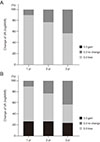Abstract
Purpose
Methods
Results
Figures and Tables
 | Fig. 1Changes in visual acuity (VA) after vitrectomy for macular hole (MH) retinal detachment at postoperative 6 months and 1, 2, and 3 years. BCVA = best-corrected visual acuity; logMAR = logarithm of the minimum angle of resolution. |
 | Fig. 2Distribution of VA changes between postoperative 6 months and 1, 2, and 3 years for (A) closed and (B) unclosed MH groups. VA = visual acuity; MH = macular hole; logMAR = logarithm of the minimum angle of resolution. |
 | Fig. 3A 50-year-old woman presenting with macular hole (MH) retinal detachment. Fundus photos demonstrate progression of chorioretinal atrophy. (A) The retina was detached within the arcade. The initial best-corrected visual acuity (BCVA) was 1.4 logarithm of the minimum angle of resolution (logMAR). Primary pars plana vitrectomy with the internal limiting membrane peeling technique was performed. (B) Three months after surgery, the retina was reattached, but the MH was unclosed. Additional surgery to close the MH was conducted. The BCVA after secondary surgery was 1.4 logMAR. (C) Two years after primary surgery, the BCVA was 1.2 logMAR. (D) Three years after primary surgery, chorioretinal atrophy progressed, and the BCVA decreased to 1.7 logMAR. The retina remained attached, and the MH remained open. |
Table 1
Comparison of baseline clinical characteristics

Data are expressed as number (%) of eyes or mean ± standard deviation.
MH = macular hole; BCVA = best-corrected visual acuity; logMAR = logarithm of the minimum angle of resolution; ILM = internal limiting membrane; C3F8 = perfluoropropane; SF6 = sulfur hexafluoride.
*Comparisons between patients with closed and unclosed MHs.
Table 4
Characteristics of patients with significant loss of visual acuity

BCVA = best-corrected visual acuity; logMAR = logarithm of the minimum angle of resolution; AXL = axial length; MH = macular hole; HM = hand motion; C3F8 = perfluoropropane; SF6 = sulfur hexafluoride; CR = chorioretinal; FC = finger count; SO = silicone oil; SRH = subretinal hemorrhage; CNV = choroidal neovascularization; IOL=intraocular lens.
Acknowledgements
Notes
Conflict of Interest Lee JE reported potential conflicts of interest with Bayer (honoraria, research fund, advisory board), Novartis (honoraria, research fund), Allergan (honoraria), Alcon (honoraria), Abbvie (honoraria, advisory board), and Samsung bioepis (consultant). No other potential conflicts of interest relevant to this article was reported.




 PDF
PDF ePub
ePub Citation
Citation Print
Print




 XML Download
XML Download